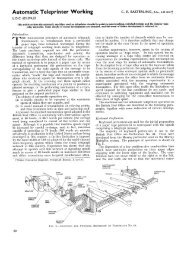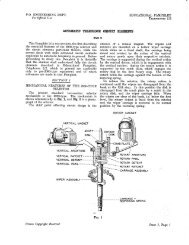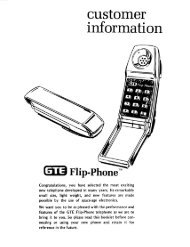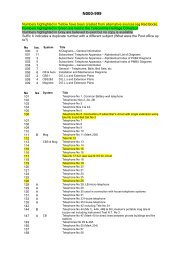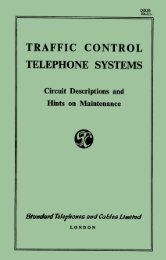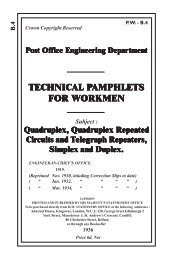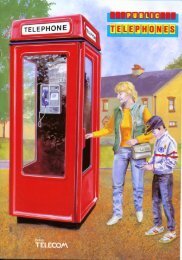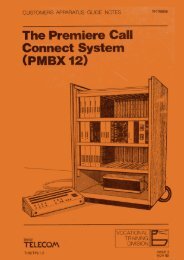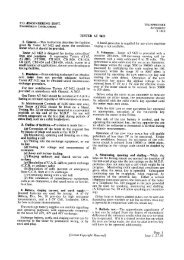The GEC 1000 Telephone - Sam Hallas
The GEC 1000 Telephone - Sam Hallas
The GEC 1000 Telephone - Sam Hallas
You also want an ePaper? Increase the reach of your titles
YUMPU automatically turns print PDFs into web optimized ePapers that Google loves.
<strong>The</strong> G.E.C. <strong>1000</strong> <strong>Telephone</strong><br />
By A. F. Jones, D.I.C.<br />
<strong>Telephone</strong> Laboratory.<br />
In this new G.E.C. telephone, a new level of performance, described elsewhere in this<br />
issue, is allied to an improved shape, to give an outstanding subscriber's instrument.<br />
At one time a common practice was to conceal or<br />
disguise telephones because their appearance<br />
detracted from the pleasing effects that were sought<br />
from the furnishings and decorations by which they<br />
were surrounded. This practice emphasised the<br />
importance of shape, which really received first<br />
acknowledgment when plastic-cased telephones<br />
with some pretensions to good shape were<br />
introduced. In nearly three decades many designs<br />
have emerged. <strong>The</strong> latest is the "G.E.C. <strong>1000</strong>"<br />
<strong>Telephone</strong>, illustrated in Fig. 1.<br />
Fig. 1.-<strong>The</strong> "G.E.C. <strong>1000</strong>" <strong>Telephone</strong>.<br />
19<br />
Shape in the telephone is essentially a matter of<br />
appeal to the eye. In an object to be lived with, a<br />
flowing line has a more pleasing effect than one that<br />
abruptly changes direction. In Fig. 2 are given the<br />
predominant lines of a variety of shapes of<br />
telephone in current use. In the new G.E.C.<br />
telephone, in contrast with others, the flow of line<br />
from the front into the cradle and out again to the<br />
back is self-evident good design. Resting in the<br />
cradle, the handset has curves that complement<br />
those of the base.
TELECOMMUNICATIONS No 22<br />
<strong>The</strong> angle of slope of the front surface of the case<br />
not only affects appearance - it also has a great<br />
effect on the ease of dialling. <strong>The</strong> most<br />
advantageous position for the eye is on a line<br />
normal to the plane of the dial. Fig. 3 shows how<br />
the plane of the dial on the "G.E.C. <strong>1000</strong>"<br />
<strong>Telephone</strong> conforms to this principle in comparison<br />
with a dial on a more horizontal plane.<br />
Ventilation of the case, to minimise internal<br />
condensation, has for many years been a feature of<br />
G.E.C. telephones for tropical service. It is not only<br />
retained in the new telephone but is so contrived as<br />
to give an added facility. On each side of the case,<br />
in front of the handset, is an indentation which<br />
provides finger grips for lifting the instrument with<br />
ease. This indentation contains a large number of<br />
small holes, which provide ventilation, but which<br />
are small enough to prevent the ingress of insects.<br />
20<br />
<strong>The</strong> same precautions against insects are found in<br />
the base, where a large number of small holes allow<br />
air to circulate and sound from the bell to escape,<br />
but prevent the entry of insects.<br />
When resting in the cradle, the curved handset<br />
gives the telephone a domed silhouette in accord<br />
with the remainder of the instrument. <strong>The</strong> increased<br />
curvature of the handset over previous types gives<br />
greater comfort to the user. Many tests have been<br />
carried out to determine the most satisfactory<br />
distance and angular relationship between the<br />
earpiece and mouthpiece. This new design suits the<br />
average person, and allows the size of the<br />
mouthpiece horn to be reduced. <strong>The</strong> latter feature<br />
improves the transmitter frequency response, and<br />
makes the telephone more hygienic.
No 22 TELECOMMUNICATIONS<br />
Fig. 3.-Illustrating the convenient positioning of the dial on the "G.E.C. <strong>1000</strong>" <strong>Telephone</strong>.<br />
<strong>The</strong>re are no moulded-in contacts in the handset ;<br />
the cord is connected direct to the capsule-type<br />
transmitter and receiver. <strong>The</strong> transmitter and<br />
receiver capsules are held in place by a screw-on<br />
mouthpiece and earpiece respectively. Being<br />
attached directly to the cord, the capsules are<br />
prevented from falling out when the mouthpiece and<br />
earpiece are removed.<br />
Base Plate Assembly<br />
All items, except the dial, are mounted on the<br />
base plate. An internal view of the instrument in<br />
Fig. 4 shows the layout of the components. All parts<br />
Fig. 4.-An internal view of the<br />
"G.E.C. <strong>1000</strong>" <strong>Telephone</strong>.<br />
21<br />
are detachable ; hence servicing is easily<br />
accomplished.<br />
Dial<br />
<strong>The</strong> G.E.C. well-known trigger-type dial is fitted<br />
and operates at ten impulses per second, with a<br />
break to make ratio of 2 : 1. Dials having other<br />
ratios can be fitted when required. A transparent<br />
plastic cover can be fitted to the back of the dial to<br />
provide protection, when necessary, against dust.
Ringer<br />
TELECOMMUNICATIONS No 22<br />
<strong>The</strong> ringer normally has a resistance of <strong>1000</strong><br />
ohms, and an impedance of 17000 ohms at <strong>1000</strong>c/s.<br />
When required for multi-party working, coils of<br />
higher impedance are fitted.<br />
Cradle Switch<br />
<strong>The</strong> cradle switch is designed to eliminate any<br />
likelihood of sticking plungers. <strong>The</strong> springsets,<br />
which are mounted so that any accumulation of dust<br />
tends to fall away, are fitted with twin contacts to<br />
give maximum reliability.<br />
Large insulators are fitted on tropical models to<br />
ensure long leakage paths between springs.<br />
Tropicalisation<br />
<strong>The</strong> three special G.E.C. features, high-quality<br />
insulation, ventilation of the case, and protection<br />
against humidity and insects are provided on all<br />
telephones supplied to tropical areas.<br />
Colour<br />
Fig. 5. - Two-tone<br />
"G.E.C. <strong>1000</strong>" <strong>Telephone</strong>.<br />
In addition to the normal black instrument, a<br />
range of two-tone telephones can be supplied in<br />
which the case is coloured and all other parts,<br />
including the dial, are black (Fig. 5). <strong>The</strong> present<br />
range of colours is ivory, red and green. <strong>The</strong> twotone<br />
telephones have the following advantages over<br />
the all-colour telephones :<br />
As only one coloured item is used, the difficulty<br />
of shade matching is eliminated. Delicate and<br />
pleasing shades can be used.<br />
<strong>The</strong> number of spare parts required by<br />
Administrations using more than one colour of<br />
telephone is greatly reduced.<br />
<strong>The</strong> colour of a telephone can readily be altered<br />
by changing the case only.<br />
Cords<br />
<strong>The</strong> telephones are fitted with the latest type<br />
instrument cords having PVC-insulated conductors<br />
and nylon overall braid. This combination of goodquality<br />
modern materials ensures a cord having long<br />
life and pleasing appearance.<br />
Published by<br />
<strong>The</strong> General Electric Company Limited of England<br />
<strong>Telephone</strong>, Radio and Television Works, Coventry, England<br />
August 1956<br />
Copyright Reserved<br />
22




